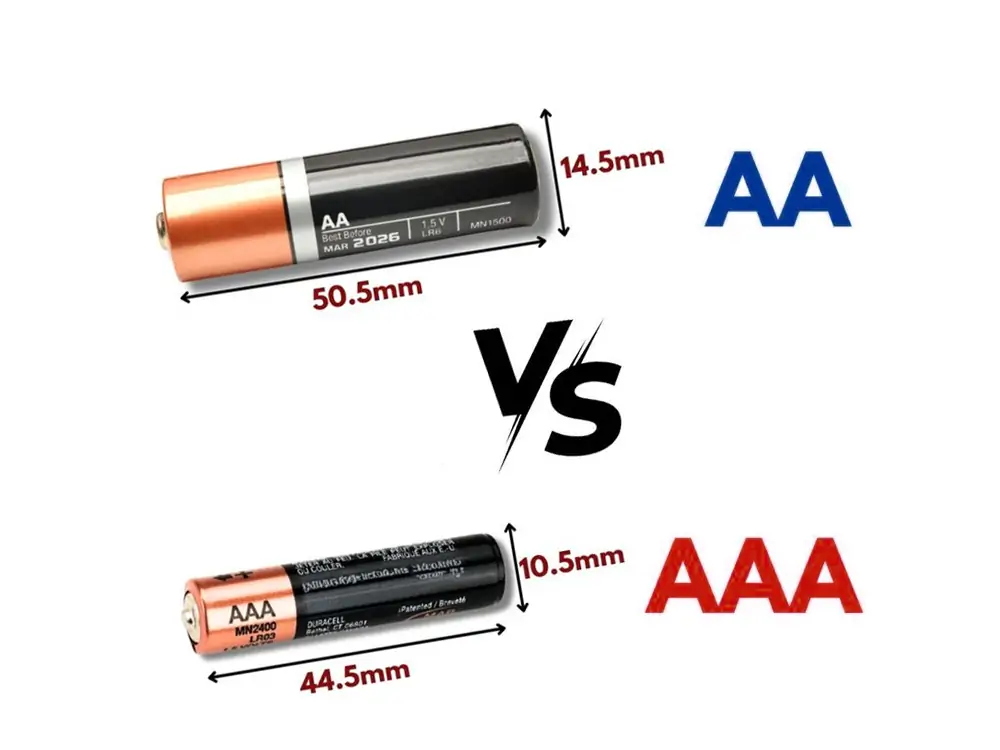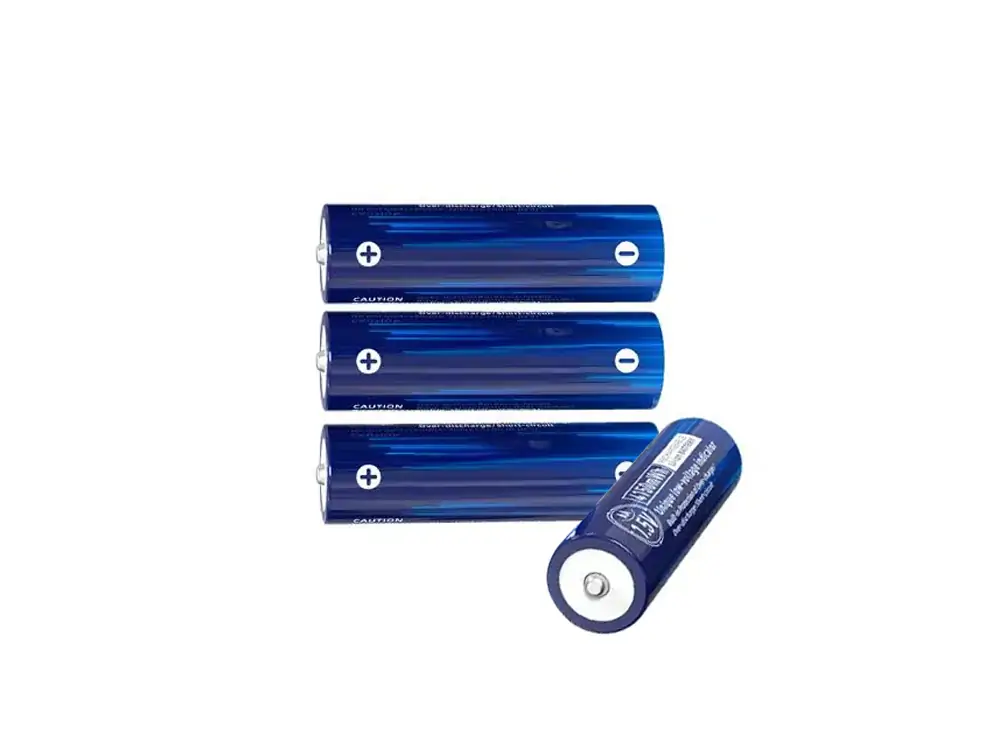As the world evolves from cabled to wireless devices, there is a greater demand for portable power sources. What better alternative is there to batteries?
Almost every household relies heavily on battery-powered devices ranging from flashlights to wireless mice and remote controls.
Two of the most common battery types are AA and AAA batteries.
However, despite their popularity and widespread use, many people still need clarification about their differences. While they may appear similar at first glance, these two batteries have specific distinguishing features.
In this article, we will discuss the differing properties of AA VS AAA batteries. This guide will certainly provide valuable insights into effectively powering your devices.
Differences Between AAA VS AA Battery
1. AA VS AAA Battery Size

The most striking difference between AA VS AAA batteries is their size and dimensions.
Also known as “double A” batteries, AA batteries are thicker and longer than AAAs. Length-wise, an AA battery measures approximately 49.2 to 50.5 mm.
In comparison, AAA batteries are slightly shorter, with an approximate length of 44.5 mm. Similarly, a double-A battery is much thicker than an AAA. It measures about 13.5 mm to 14.5 mm in diameter, while a triple-A battery is only around 10.5 mm.
AA vs AAA battery dimensions are key in determining which devices they can power and their energy capacity.
2. AA VS AAA Battery Capacity
Another crucial difference between AAA battery VS AA battery is their capacity. The battery’s capacity determines how long it can power a device.
Due to their larger size, double-A batteries can hold more energy-producing materials, resulting in a higher capacity and longer runtime.
For example, a standard alkaline AA battery has a capacity of up to 3000mAh and can run continuously for 24 hours in high-drain devices.
In contrast, triple A batteries provide 800 to 1200mAh and a runtime of 10 hours in high-drain devices. This significant difference in capacity explains why gadgets like digital cameras or remote-controlled toys use AA batteries.
Meanwhile, low-power devices like TV remotes or small LED flashlights use AAA batteries.
Another popular choice is the 18650 Li-ion battery, known for its high energy density, rechargeability, and long cycle life.
3. AA VS AAA Battery Weight
The size difference between AAA VS AA batteries naturally leads to a variation in weight. In particular, AA batteries are heavier than AAA batteries. This is of course, due to their larger size and increased number of internal materials.
A typical alkaline AA battery weighs approximately 23 grams, while an alkaline AAA battery weighs about 11 grams.
You might wonder how exactly the weight of these batteries affects their function. But picture a situation where multiple batteries are needed to power a device.
For example, a device that uses four AA batteries will be heavier than one that uses four AAA batteries. This added weight could compromise portability and comfort for the user.
4. AA VS AAA Battery Voltage
An interesting fact about AA batteries VS AAA batteries is that they produce the same nominal voltage. Irrespective of their differences in size, weight, or capacity, the output is the same.
Specifically, both battery types provide 1.5 volts when fresh and gradually decrease to 0.8 volts as they near the end of their life. This consistent voltage means devices designed for either battery type will receive the same electrical pressure.
However, AA batteries have higher capacities to maintain their voltage level for extended periods.
AAA Battery VS AA Battery: Common Applications and Device Compatibility

1. AAA Battery VS AA Battery: Applications
The choice between an AA battery VS AAA shouldn’t depend on size and weight alone. Instead, it is about matching a device with the correct power source.
As our homes and workplaces fill with more battery-powered devices, it becomes important to know what to use for what.
In other words, you must know the exact battery type that would suit your application without relying on just size as a determinant.
Applications of AA Batteries
- High-power and long-duration devices:
The large capacity of AA batteries makes them ideal for power-hungry devices.
Digital cameras, in particular, rely on AA batteries to power their LCD screens and flash functions.
Similarly, professional audio equipment like field recorders and wireless microphones benefit from AA batteries.
- Gaming equipment:
The gaming world demands skill, precision, and a reliable power source to keep up with performance.
For instance, Xbox wireless controllers and Nintendo Wii remotes, use AA batteries that help players extend game sessions.
- Health and Monitoring Devices
Healthcare is a delicate practice that requires perfection in every treatment.
Many medical devices need a reliable power source to withstand long service hours; hence, AA batteries are the preferred option due to their great capacity and runtime. These devices include thermometers, blood pressure monitors, and baby monitors.
- Computer Peripherals
AA batteries are perfect for frequently used computer accessories like wireless mice and keyboards. These batteries can provide power for weeks to months before needing replacement.
This long-lasting performance, combined with their availability, makes AA batteries the best choice for computer accessories.
Applications of AAA Batteries
- Remote control devices:
AAA batteries are portable power sources for small gadgets. TV remotes and AC control systems rely on them for their lightweight design and reliable performance.
Other security devices, namely garage door openers and car key fobs benefit from AAA batteries. Their small forms make them easy to carry and use.
- Personal Electronics:
Triple-A batteries power a diverse range of personal electronics where size and weight matter most. From small audio players to earbud charging cases, these batteries balance power and compactness.
- Lighting
AAA batteries offer versatility in portable lighting. Their small size benefits book lights and LED penlights, while bicycle safety lights and camping headlamps rely on their output.
AAA batteries also power holiday decorations and string lights, making the festivities a true marvel.
- Children’s Toys
AAA batteries bring electronic learning toys and musical greeting cards to life. They power light-up shoes, basic remote-control cars, and electronic pet toys.
Their compact size makes them perfect for small toy compartments while providing enough power for playtime.
2. AA Battery VS AAA Battery: Device Compatibility
Power requirements:
Devices with motors or bright displays have higher power needs and would, therefore, require AA batteries.
On the other hand, simple electronics have low power requirements, making AAA batteries the ideal choice.
Runtime expectations:
It is possible to use AAA batteries in high-drain devices. However, be prepared for frequent battery changes and extra spending.
AA batteries in low-drain gadgets can last several months to a year under normal conditions.
Physical design factors:
Keeping things simple;
- Slim devices like pocket calculators and TV remotes require AAA batteries.
- Weight-sensitive applications, including wearable devices, prefer AAA batteries.
- Devices that need structural support use AA batteries, as their larger size can contribute to the device’s stability and durability.
Multi-battery configurations:
Use AAA batteries for devices that require four batteries or more to perform. This will help keep the device’s total weight manageable and comfortable.
High-power devices might use multiple AA batteries in series for increased voltage. This setup is common in professional equipment with huge power demands.
AA Battery VS AAA Battery: Available Chemical Compositions
1. Alkaline
This is the most common and cost-effective option. Alkaline batteries offer reliable performance for everyday devices. They provide steady power output and reasonable shelf life, making them suitable for most consumer applications.
2. Lithium
Lithium batteries are more powerful and last longer than alkaline batteries, but are pricier. They perform particularly well in high-drain devices and harsh temperature environments.
3. NiMH
NiMH rechargeable batteries are an eco-friendly and cost-effective choice for both sizes. While their initial cost is higher, they quickly become economical with continuous use.
Brand Recommendations
1. Duracell
Duracell is a popular brand known for its copper and black design. It is an industry leader in the battery market and has remained so for years through constant advancement.
Their flagship product is the Coppertop line, which outlasts ordinary carbon-zinc batteries by 30% or more.
Moving up the product range is the company’s latest advancement in battery technology – the Duracell Optimum Series. This series has a unique design that provides up to 200% more power in high-drain devices.
Key Features of Duracell Batteries include;
- A 10-year guarantee during storage
- Leak protection technology
- Consistent power delivery throughout the battery’s life cycle
- Special coating that prevents corrosion during long-term storage
- Available in bulk packaging for better value
2. Energizer
Energizer’s Ultimate Lithium and Max alkaline batteries offer exceptional longevity and performance.
The Ultimate Lithium line offers a 20-year storage life and can maintain 99% of its power when stored properly.
Meanwhile, the Max alkaline line has a PowerSeal technology that prevents leakage for two years after usage. It is designed for medium-drain devices and offers up to 10 years of fresh power.
Energizer is best for:
- Emergency kits
- GPS devices
- Headlamps
- Portable radios
3. Rayovac
This brand offers excellent value while maintaining good quality standards. Moreover, their High Energy line competes well with premium brands at a cheaper price.
Notable features include;
- Good shelf-life (up to 10 years)
- Competitive Pricing
- Reliable performance in standard devices
4. Eneloop (Panasonic)
This brand leads the rechargeable battery market. It is renowned for its low self-discharge and consistent performance in cold temperatures.
In addition, they can be pre-charged using solar power and maintain 70% charge after 10 years of storage.
Moreover, they can be recharged up to 2100 times and are suitable for everyday devices.
5. Legend Batteries

Legend Batteries is a prominent Chinese manufacturer that focuses on lithium-ion batteries. The brand offers customers bulk packaging options and customization services at home and abroad. It also follows strict safety and performance standards in its manufacturing process. Visit its website for more information.
